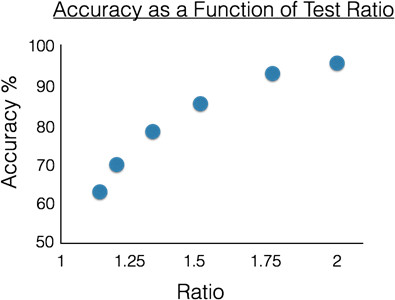Approximate Number Sense Test
Обзор
Source: Laboratory of Jonathan Flombaum—Johns Hopkins University
A common carnival game is to ask people to guess the number of jellybeans packed into a jar. The chances that anyone will get the exact number right are low. But what about the chances that someone will guess 17 or 147,000? Probably even less than the chances of guessing the correct answer; 17 and 147,000 just seem irrational. Why? After all, if the beans cannot be taken out and counted one-at-a-time, how can someone tell that an estimate is too high or too low?
It turns out that in addition to verbal counting (something clearly learned), people appear to possess hardwired mental and neural mechanisms for estimating numbers. To put it colloquially, it is what might be called an ability to guesstimate, or “ballpark.” Experimental psychologists call it the “Approximate Number Sense,” and recent research with an experimental paradigm of the same name has begun to uncover the underlying computations and neural mechanisms that support the ability to guesstimate.
This video demonstrates standard procedures for investigating nonverbal numerical estimation with the Approximate Number Sense Test.
Процедура
1. Stimuli and trials
- Program the experiment in Psychopy, MATLAB, or something similar (a free version can also be downloaded for non-commercial uses at www.panamath.org).
- Design all trials in the experiment to look more or less the same.
- Divide the display in half. Use a grey background.
- One side of the display shows a collection of blue circles.
- The other side shows a collection of yellow circles.
- Draw
Результаты
To graph the results from a participant, average performance as a function of the ratio on each trial (Figure 2). For example, across all 20 trials with a ratio of 2:1, in what fraction did the participant supply the right answer?

Figure 2. Sample results from a single participant in the approximate number test. Performance, measured as response accur
Заявка и Краткое содержание
People differ between one another considerably in terms of the acuity of their approximate number sense. To characterize differences between individuals, experimental psychologists generally test to find the smallest ratio a person can tell apart with 75% accuracy. As shown in Figure 2, it is a ratio somewhere between 1.25 and 1.5. This number is just a quick way of summarizing how acute an approximate number sense a person has. But beyond the fact that there are large differences between people—on
Перейти к...
Видео из этой коллекции:

Now Playing
Approximate Number Sense Test
Cognitive Psychology
7.6K Просмотры

Dichotic Listening
Cognitive Psychology
26.7K Просмотры

Measuring Reaction Time and Donders' Method of Subtraction
Cognitive Psychology
44.4K Просмотры

Visual Search for Features and Conjunctions
Cognitive Psychology
26.9K Просмотры

Perspectives on Cognitive Psychology
Cognitive Psychology
7.0K Просмотры

Binocular Rivalry
Cognitive Psychology
8.0K Просмотры

Multiple Object Tracking
Cognitive Psychology
7.8K Просмотры

Mental Rotation
Cognitive Psychology
13.2K Просмотры

Prospect Theory
Cognitive Psychology
11.2K Просмотры

Measuring Verbal Working Memory Span
Cognitive Psychology
12.6K Просмотры

The Precision of Visual Working Memory with Delayed Estimation
Cognitive Psychology
5.2K Просмотры

Verbal Priming
Cognitive Psychology
15.0K Просмотры

Incidental Encoding
Cognitive Psychology
8.6K Просмотры

Visual Statistical Learning
Cognitive Psychology
7.1K Просмотры

Motor Learning in Mirror Drawing
Cognitive Psychology
55.6K Просмотры
Авторские права © 2025 MyJoVE Corporation. Все права защищены
